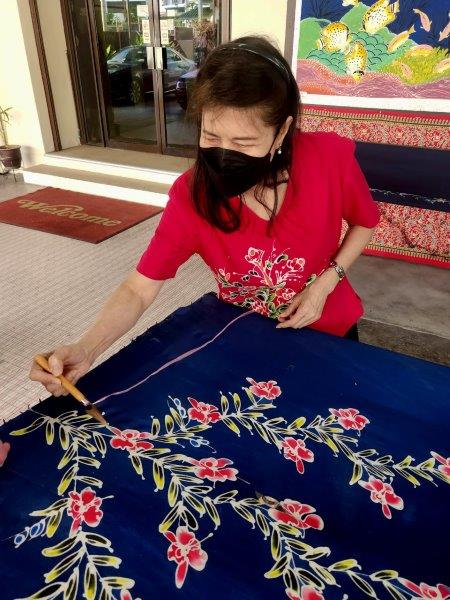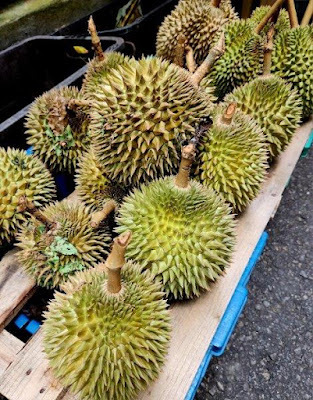Continuing on around the island, our guide also took us to a place that is famous for local products (white coffee, chocolates, tea, honey) and another store that offered a short demonstration on Malaysian batik with lots of batik products for sale (we didn’t buy anything).
 |
| batik demonstration |
 |
| spouted tool (canting) holds melted wax |
 |
| salesgirl demonstrating different ways to wear garment |
We continued on our 42 mile trip around the island. We saw many durians growing in trees as well as durian stands. Durians (called the King of Fruits) are a VERY stinky fruit that is popular in Asian culture. There are many durian farms in this area and also durians that grow naturally. They smell so bad that they are mostly banned from public transportation. People have been known to die from durians falling off a tree onto their head! Durians are the kind of fruit that one must acquire a taste for (grow up eating them) and our guide who likes them told us that most locals prefer eating them in an open air stand vs taking them in a car. If you’ve not smelled one, just take my word for it. But fresh off the tree and outdoors, the smell isn’t so awful. I actually tried some durian ice cream when we were in Indonesia back in 2012. I asked myself "it's ice cream, how bad can it be?" One bite and it went straight into the trash can!
 |
| durian - "King of Fruits" |
.jpg) |
| roadside durian stands |
 |
| fresh durian |
We stopped at a roadside fruit stall. The guy running it had many different spices – cloves, nutmeg, cinnamon, cacao, etc. as well as fresh fruits for sale. I bought some nutmeg oil which he convinced me is good to rub on achy joints. We'll see... It’s interesting to learn how every part of the nutmeg is used. Sugar is added to the shaved flesh and eaten as a dessert, the seed is of course used as a seasoning in cooking and the red web-like coating that surrounds the seed is mace, which is also used in cooking.
 |
| parts of nutmeg - flesh, mace, seed |
 |
| mace (left) seeds (right) |
 |
| betel nut (left) cacao (red & yellow) |
 |
| cacao, bananas |

cacao seeds are used to make chocolate
From there we drove
through a traditional Malay (Muslim) village where the houses are built on stilts.
They were originally built with thatched roofs but over time have been replaced with tin. But the tin rusted so many of the roofs are orange. Now they have started using some type of protective coating on the tin roofs and those are green. So it looks like somewhat of a hodge podge. Our guide also pointed out a Muslim cemetery. It was very unkempt and there were
different shaped headstones for men and for women.
We also stopped by a local market where vendors were selling produce and fresh fish. Most of the activity in the market takes place earlier in the day. Behind it was the pier where fish were brought in.
 |
| local fisherman's pier |
 |
| chopping fish for bait |
 | |
| boats docked for the day |
Overall, we felt like we got to see a lot in a short period of time without having to endure a lot of heat and walking, so all in all it was an interesting tour.

No comments:
Post a Comment